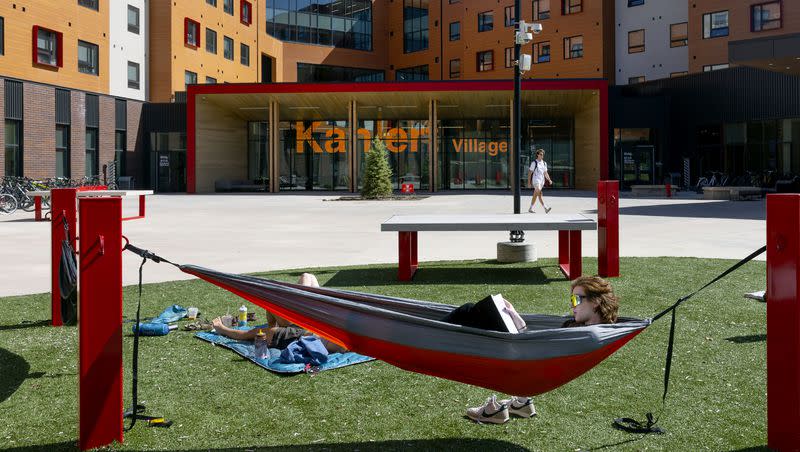Utah needs to pay attention to waning confidence in higher education, says University of Utah president

The University of Utah and other public colleges and universities in Utah are feeling the effects of declining confidence in institutions of higher education nationwide.
One impact has been a decline in recent high school graduates who are interested in going to college.
“We are seeing a massive change in the attitudes towards higher ed nationally. I think those attitudes are also reflected here in the state,” University of Utah President Taylor Randall told members of a legislative committee on Tuesday.
A 2023 Gallup poll indicates confidence in higher education plunged from 57% in 2015 to 36% in 2023.
“You will see that since 2015, there’s no public institution that seems to have lost more confidence (among) Americans than higher ed. I think that is something that we have to listen to, and we have to address,” Randall told members of the Utah Legislature’s Higher Education Appropriations Subcommittee.
In Utah, a recent Deseret News/Hinckley Institute of Politics poll showed 52% of Utahns either had a “great deal” or “quite a lot” of confidence in institutions of higher education in Utah. Conversely, 31% said they had “some” confidence in Utah’s colleges and universities and 14% said they had very little.

The poll of 801 Utahns was conducted Jan. 16-21. It has a 3.02% margin of error.
Many of Utah’s public colleges and universities reported to Utah lawmakers that they have had experienced declines in graduating high school seniors in Utah applying to college.
Snow College President Stacee McIff said public school superintendents in the college’s service area have told him “70% of high school seniors say they don’t see themselves as going to college. It’s a problem with the national narrative.”
The Wall Street Journal reported recently that “we’ve lost faith in higher education,” McIff said, addressing the appropriations subcommittee last week.
“Part of the reasons are, No. 1, we went away from the technical programming, high-demand technical jobs and kind of disrespected that training, and then, the cost. So people have moved away from wanting to participate in higher education,” she said.
In rural areas, “people are saying, ‘Well, what’s the value?’ I don’t want to go into the classroom again,’” McIff said.
College doesn’t have to be a narrowly defined experience, she said.
“It doesn’t have to be sitting in a classroom doing work that you didn’t love doing in high school. We can redefine that,” she said.
Research shows earning a college degree multiple benefits.
A 2021 report by the University of Utah’s Kem C. Gardner Policy Institute showed college graduates have higher lifetime earnings, economic mobility, healthier lifestyles and a higher likelihood of receiving employer-provided health insurance.
Related
As college applications slow, there are thousands of unfilled jobs in the workforce. Some require certificate training available at technical or community colleges.
The U. plans to launch an initiative takes aim at both challenges and will require a departure from the traditional mode full-time college attendance and part-time work
“The first idea and hypothesis ... is that the traditional model of a full-time student and a part-time job is just not feasible for those that are not coming. We’ve really got to flip the model to a full-time job and a part-time student. Now that’s going to go against some completion metrics but I think if we care deeply about education, that knowledge will actually lift people in the long term,” Randall said.
The university would actively recruit high school seniors to fill jobs at the university where they could qualify for tuition benefits.
“We’re actually going to try to craft jobs where a student can get paid several hours a week to work. We’re gonna go out and recruit this set of students that can’t necessarily afford college right away, but we’ll get them full-time jobs, we’ll get them into a tuition benefit. We want to increase dramatically the number of students that we’re actually employing on our campus,” Randall explained.
These students will have advisers who have been trained to inform the students that “the University of Utah may not be the first place you start, particularly in our health care system. You may want to go get a certificate at Davis Tech, or Salt Lake Tech or Salt Lake Community College, then enter in our system and get going,” he said.
“But what’s important is they’ve taken time to map out pathways where they can both progress as employees in our system, but they can also dramatically increase their education to increase their value in society,” Randall said.
Results of the Deseret News/Hinckley Institute of Politics poll reflected higher confidence in the higher education system among people who had earned bachelor degrees or performed postgraduate work.
A combined 62% of people ages 57 and older said they either had a “great deal” or “quite a lot” of confidence in Utah’s higher education institutions compared 48% for the respondents ages 25-40 and those 41-56.
Across income groups, confidence in higher education was higher with those with higher household incomes. Among those with incomes below $24,000 annually, 44% expressed firm confidence compared to 58% for those with incomes $75,000 to $99,999. For those earning $100,000 or more, 28% said they had a “great deal” of confidence and 28% said they had “quite a lot,” for a combined total of 56%.
The split between men and women polled was notable, too. Fifty-nine percent of female respondents expressed firm confidence while just 47% of men said they had similar degrees of confidence.

